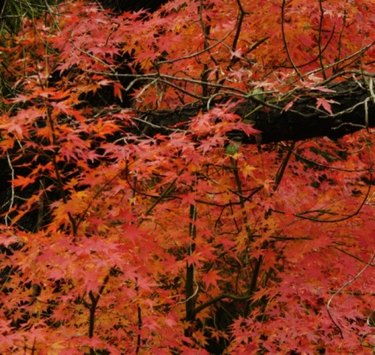
Attractive branching silhouettes and interesting leaf shapes and colors make Japanese maples among the most widely planted, small, ornamental trees in the Untied States. Two species are referred to as Japanese maples: Acer palmatum and A. japonicum. The latter is often also called fullmoon maple. Hundreds of cultivars exist, all with different mature heights, branching widths and leaf characteristics. Slow growing, these trees may be planted near buildings as long as they're not planted too closely based on expected mature plant sizes.
Types
Video of the Day
Between the two species of Japanese maples, two different forms exist among the numerous cultivars. Upright Japanese maples grow anywhere from 10 to 40 feet tall and 15 to 30 feet wide in the course of 30 to 60 years. Dwarf or weeping Japanese maple cultivars remain smaller, anywhere from 5 to 10 feet tall and 10 feet wide. When choosing a tree to plant within 15 feet of a house, dwarf or weeping Japanese maple selections are a smarter option than upright, larger types.
Video of the Day
Root Growth
All Japanese maples, regardless of species, grow roots primarily in the top 24 to 36 inches of soil. The roots extend radially from the trunk in all directions. A Japanese maple's roots do not stop at the end of the canopy branches' reach. The roots continue growing 5 to 20 feet beyond seeking water and nutrients. Planting a Japanese maple too near a house inhibits healthy root growth and extension.
Spacing
Dwarf or weeping Japanese maples grow slowly and typically don't mature wider than 10 feet. Plant such smaller-maturing cultivars no closer than 6 feet from a house's foundation, sidewalk or driveway. The measurement is made from the tree trunk to the structure. Larger, upright-growing Japanese maple cultivars must not be planted as close. Although the issue will not become apparent for 20 to 40 years, tall maples push branches and roots tightly against the house. Upright branches may become confined by soffets and building overhangs.
Tips
Choose a cultivar of an appropriate mature size depending on where you want to plant a tree near the house. Since Japanese maple trees grow slowly, they often cost more than other plants. Plant the tree so it has room to grow during its lifetime without intruding on the house facade or foundation. Do not plant Japanese maples in a narrow planting bed abutting the house foundation.